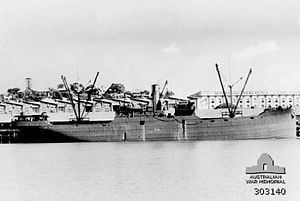Identification ON 219585 Beam 46 ft 2 in (14.07 m) Launched 1920 Draft 7.6 m | Tonnage 3,290 GRT Draught 25 ft (7.6 m) Length 99 m Builder Newark | |
 | ||
Name Riverside Bridge (1920—1928)
Point Arena (1928—1937)
Coast Farmer (1937—sinking) Fate Sunk by torpedo July 20, 1942 | ||
Coast Farmer, gaining the name in 1937 and previously bearing the names Point Arena (1928) and Riverside Bridge (1920), was a U.S. Shipping Board Emergency Fleet Corporation Design 1023 vessel ordered under the name Minnewawa and built as hull #103 by Submarine Boat, Newark New Jersey in 1920 Coast Farmer is noted as being a part of the Pensacola Convoy landing the supplies and troops intended for the Philippines in Darwin, Australia after being diverted on the news of the attack on Pearl Harbor. The ship became even more notable being the first of only three ships successfully running the Japanese blockade into the Philippines; leaving Brisbane February 1942. Coast Farmer was torpedoed and sunk off Jervis Bay, New South Wales on July 20, 1942.
Contents
Commercial to World War II Service
The Gulf Pacific Mail Line operated the ship as Point Arena from 1928 to 1937. The ship was acquired and operated as Coast Farmer by the Coastwise Line, a coastal line associated with Coastwise (Pacific Far East) Lines, until taken for war time service by the War Shipping Administration on 22 December 1941, the date the Pensacola Convoy reached Brisbane Australia.
Pensacola Convoy
Coast Farmer was one of three merchant cargo ships in the convoy and largely carried civilian supplies for the shops of Guam and Manila. After arrival the Coast Farmer along with Meigs and the Admiral Halstead were retained by United States Forces in Australia (USFIA) for operations in Australia.
Australia-Philippine Operations
Coast Farmer was provided a gun crew from the 453d Ordnance Company, loaded with military supplies including 2,500 tons of rations and departed Brisbane February 10, 1942 for the Philippines where the ship delivered its cargo at Anakan, Mindanao, on 17 February. On departure a member of the gun crew sent ashore to repair machine guns did not return in time and was left behind.
John A. Matson, master of Coast Farmer on this operation, was later awarded the Army's Distinguished Service Medal and the Merchant Marine Distinguished Service Medal. Coast Farmer became one of only three ships, the others being Dona Nati and The China Navigation Company's Anhui, to successfully break the Japanese blockade. The supplies brought by the Coast Farmer were destroyed in transshipment when the smaller ships trying to reach Corregidor were sunk by gunfire from Japanese naval forces off Mindanao.
On her return she was one of seven vessels in the USFIA Army fleet and one of three assigned indefinitely. Subsequently General MacArthur received confirmation the vessel was under War Shipping Administration charter for his use without restriction. The Coast Farmer was engaged in supporting the war effort in coastwise shipping when torpedoed by the Japanese submarine I-11 and sunk off Jervis Bay, New South Wales July 20, 1942. One crew member was lost. The ship was hit amidships at about 2 a.m. and sank within twenty minutes with the submarine surfacing and examining the ship by searchlight.
